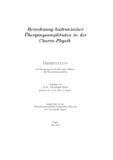Citation link:
https://nbn-resolving.org/urn:nbn:de:hbz:467-5620| Dokument Type: | Doctoral Thesis | metadata.dc.title: | Berechnung hadronischer Übergangsamplituden in der Charm-Physik | Other Titles: | Calculation of hadronic transition amplitudes in charm physics | Authors: | Klein, Christoph | Institute: | Fakultät IV - Naturwissenschaftlich-Technische Fakultät | Free keywords: | QCD-Summenregeln, Charm-Physik, Formfaktoren, hadronische Kopplungskonstanten, Flavourphysik, QCD sum rules, charm physics, form factors, hadronic couplings constants, flavour physics | Dewey Decimal Classification: | 530 Physik | GHBS-Clases: | UHXT | Issue Date: | 2011 | Publish Date: | 2011 | Abstract: | Übergänge von Hadronen mit einem charm-Quark sind von wichtiger Bedeutung, da sie die Moglichkeit bieten, die CKM-Matrixelemente V cd und V cs zu bestimmen, sowie interessante Kanäle für die Suche nach neuer Physik zur Verfügung stellen. Quarks sind allerdings in Hadronen gebunden, und man braucht eine verlässliche Beschreibung dieses Effekts, um die zugrunde liegende Flavour-Dynamik untersuchen zu konnen. Dazu ist die Verwendung nichtperturbativer Methoden erforderlich, um entsprechende Übergangsamplituden bestimmen zu konnen. Die Ergebnisse solcher Berechnungen erlauben zudem umgekehrt auch einen Test der QCD und konnen zu einem tieferen Verständnis der Bindungsstruktur von Hadronen beitragen. In dieser Dissertation werden mit der Methode der QCD-Lichtkegelsummenregeln zwei Themengebiete untersucht. Das erste sind die Formfaktoren für die semileptonischen Zerfälle D →πℓ ν ℓ und D → K ℓ ν ℓ , für die - unter Nutzung neuester Ergebnisse - aktuelle Werte bestimmt werden. Da hier keine direkte Vorhersage im gesamten kinematischen Bereich moglich ist, werden sie unter Verwendung geeigneter Parametrisierungen extrapoliert und stimmen sehr gut mit dem Experiment überein. Das zweite Gebiet sind die Übergänge von Baryonen mit einem charm-Quark in Nukleonen. Auch hier werden die entsprechenden Übergangsformfaktoren, sowie zusätzlich die hadronischen Λ c D (*) N - und Σ c D (*) N -Kopplungskonstanten (unter Verwendung doppelter Dispersionsrelationen) berechnet. Letztere sind insbesondere für die Beschreibung hadronischer Wechselwirkungen von Bedeutung, wie der Produktion von charm-Quark-Hadronen in Proton-Antiproton-Kollisionen. Dabei tritt zudem das Problem auf, dass beide Paritätszustände der betrachteten Baryonen in die verwendete Darstellung einfließen, zu deren Trennung eine konsistente Methode vorgestellt wird. Transitions of charmed hadrons are of significant importance, since they provide possibilities to extract the CKM matrix elements V cd and V cs from experimental data as well as interesting channels to search for new physics effects. However, quarks are bound in hadrons, and it is necessary to describe this effect in a reliable way, to study the underlying flavour dynamics. For this, one has to use nonperturbative tools, to determine the corresponding transition amplitudes. The results of such calculations can furthermore be of use, to test the predictions of QCD and to contribute to a deeper understanding of the structure of hadrons. In this thesis two topics are investigated using the method of QCD light-cone sum rules (LCSRs). The first topic consists in the form factors of the semileptonic decays D → πℓ ν ℓ and D → K ℓ ν ℓ , for which new results are calculated using up-to-date input values. Since LCSRs are not applicable in the whole range of kinematics, they are extrapolated by the use of appropriate parametrisations and the results agree well with experimental data. The second topic are the transitions of charmed baryons to a nucleon. Here the corresponding transition form factors and in addition the hadronic Λ c D (*) N and Σ c D (*) N coupling constants are calculated - the latter by the consideration of double dispersion relations. These coupling constants are of special interest for the description of hadronic interactions, like open charm production in proton-antiproton-collisions. Furthermore there appears the problem, that both parity states of a baryon contribute to the considered functional representation, for which a consistent way to seperate them is presented. |
URN: | urn:nbn:de:hbz:467-5620 | URI: | https://dspace.ub.uni-siegen.de/handle/ubsi/562 | License: | https://dspace.ub.uni-siegen.de/static/license.txt |
| Appears in Collections: | Hochschulschriften |
This item is protected by original copyright |
Page view(s)
466
checked on Nov 25, 2024
Download(s)
167
checked on Nov 25, 2024
Google ScholarTM
Check
Items in DSpace are protected by copyright, with all rights reserved, unless otherwise indicated.


